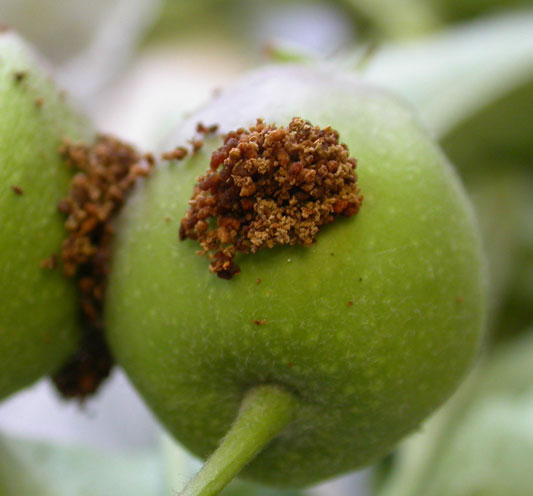Codling Moth
HOSTS
- Apple
- Crabapple
- English Walnut
- Hawthorn
- Peach
- Pear
- Quince
DESCRIPTION
Codling moth (Cydia pomonella) is the most serious pest of apple and pear worldwide. In most fruit producing regions and home yards in Utah, fruit must be protected to harvest a crop.
In Utah, there are two to three generations of codling moth each year. In northern Utah, there are typically two full generations and a partial thrid generation. In southern Utah, most or all of a thrid generation will occur. First generation moths begin to emerge about bloom time and peak in June in northern Utah. Second generation moths begin emerging in late June to early July and peak in late July to early August. Third generation moths are active from about mid August to mid September before declining day length induced the end of activity for the year.
BIOLOGY
Larva are 1/10 inch long upon hatching, and pale white with a black head. When full grown, larva are 1/2 to 3/4 inch long, and tan to pink with a brown head. They feed on terminal leaves and bore into shoots before seeking fruit.
Pupa are 1/2 inch long and brown. They pupate inside silken cocoons under bark and in other protected sites.
Adults are 1/2 inch long, mottled gray and brown moths. They have bands of alternating gray and white on the wings with a bronze to copper spot on the tip of each forewing. Moths lie camouflaged against tree bark during the day with wings held over their tent-like body.
Eggs are pinhead sizeds, flat, oval, and translucent at first, later turning white. They are laid singly on fruit or on upper surface of leaves near fruit.
SYMPTOMS
- Deep entries from larvae tunneling to the center of the fruit
- Brown frass (excrement) extrudes from entry and exit holes
- Fruit attacked during the first generation often drops prematurely
- Stings - healed shallow or aborted entries
GENERAL MANAGEMENT
Mating Disruption:
Detailed knowledge of insect biology, development timings, and limitations of mating disruption are needed to use it successfully. Substantial fruit damage could result from improper use. The orchard size, proximity to outside sources of codling moth, and dispenser placement and application rate can all influence the success of this tactic. The typically small size of apple and pear blocks in Utah (less than 10 acres) and the high codling moth populations reduce the effectiveness of mating disruption in Utah as compared to other areas of the West. Mating disruption is not effective in home yards or orchards smaller than 10 acres.
Current insecticide choices include synthetic materials, microbial and botanical insecticed, and petroleum oils. Use of pheromone trapping in combination with the degree-day model is highly recommended to accurately determine codling moth development for your location.
If the orchard is large (more than 10 acres) and moths are only found in border traps, treating four to five border rows may markedly reduce the amount and number of insecticide applications. This tactic is primarily used after first and second cover sprays that have been applied or in conjunction with mating disruption.
Rotate among insecticide classes to prevent development of resistance to insecticides in the codling moth population.
More information on insecticides- Click Here
Cultural and Mechanical Controls:
- Fruit thinning: Newly hatched larvae often seek out protected sites for entry, and thinning fruit to just one apple/cluster can limit successful entries. Fruit thinning also allows for improved insecticide coverage on the entire fruits.
- Trunk banding: Place corrugated cardboard bands (2-3 inches wide) around trunks of trees in May or August. Remove and destroy bands before mid to late June or in late October to November. Most effective on smooth-barked varieties and in smaller, isolated orchards without nearby sources of codling moth.
- Fruit bagging: Exclude codling moth larvae by placing paper bags or specially-designed bags over fruit.
Biological Control:
Use of more selective and lower toxicity insecticides enhances populations of beneficials (predaceous and parasitic arthropods). Native enemies alone, however, do not provide satisfactory control. Recent efforts to introduce parasitoids from native habitats of codling moth in Eurasia are promising. The egg parasitoid, Trichogramma, has shown potential especially in combination with other lower toxicity tactics.
How to Trap Codling Moths




